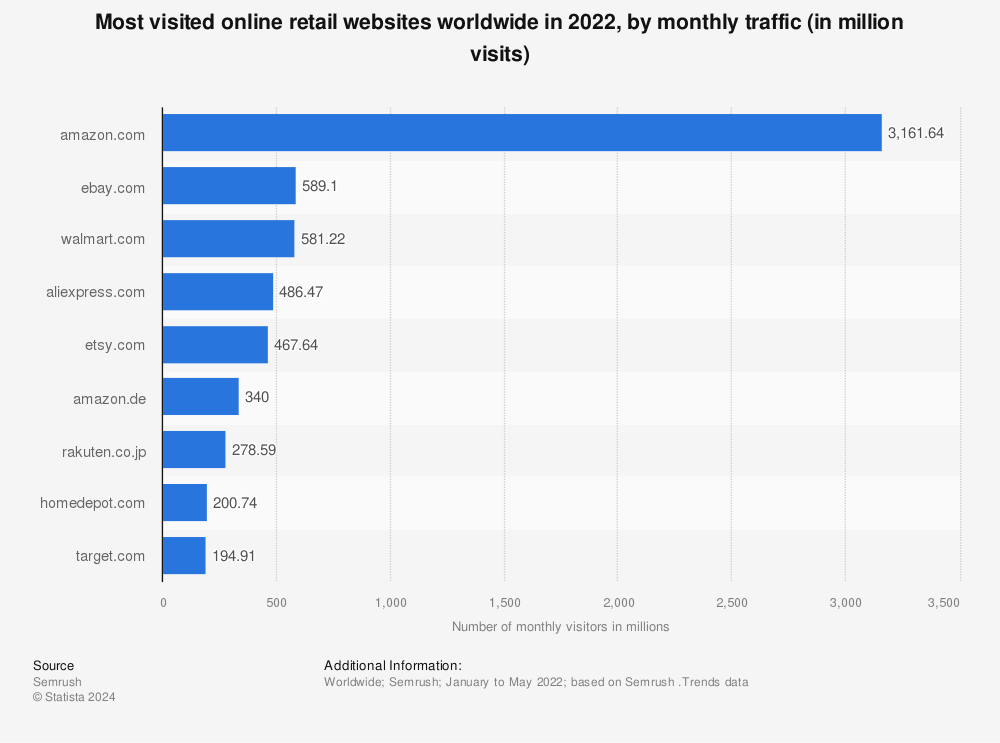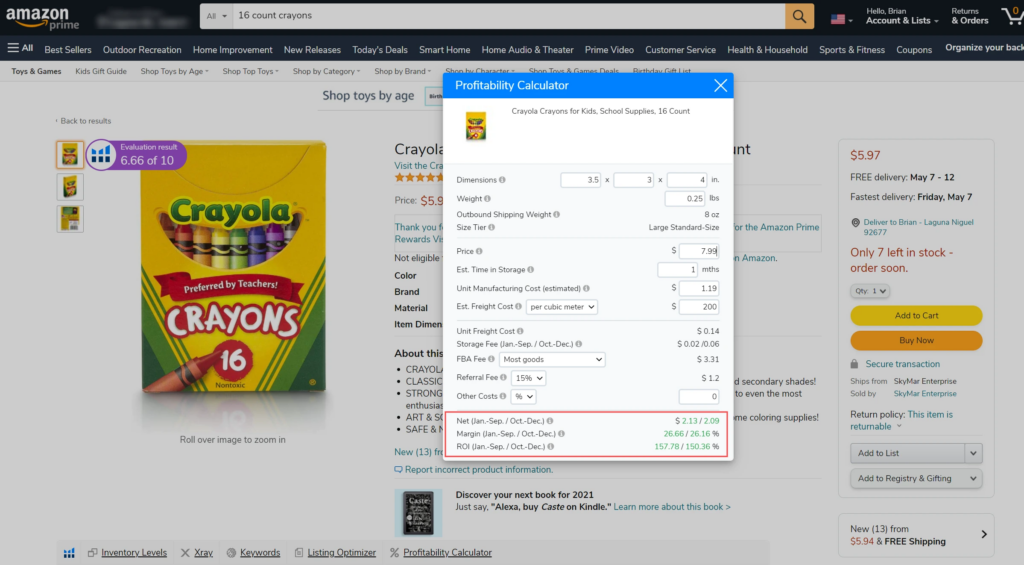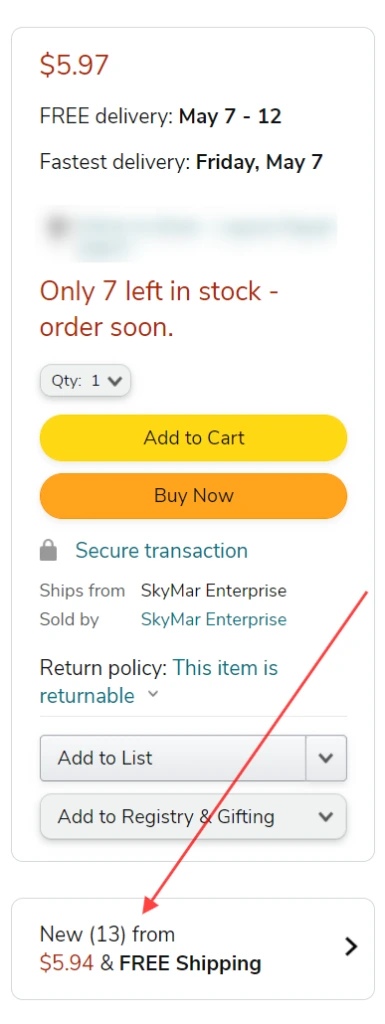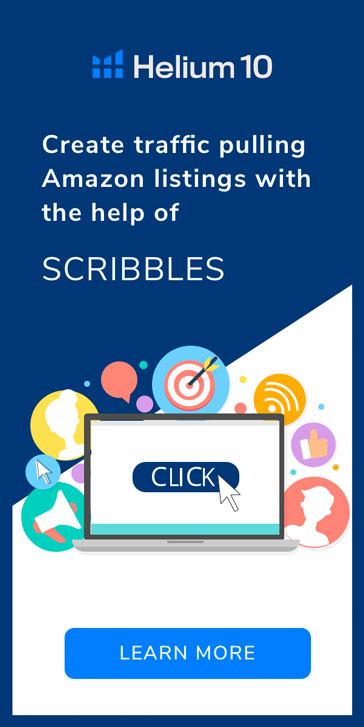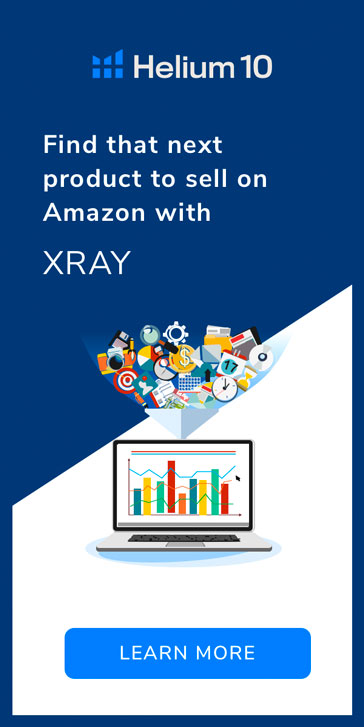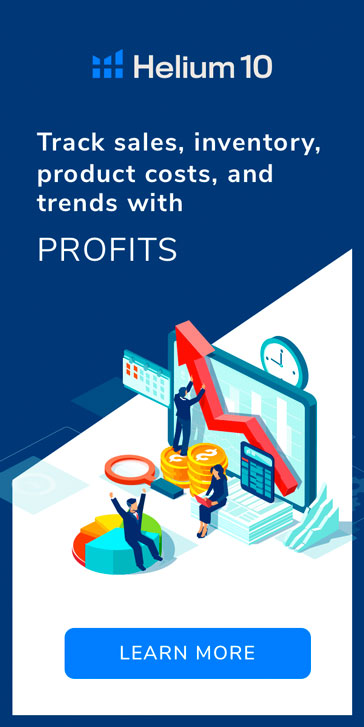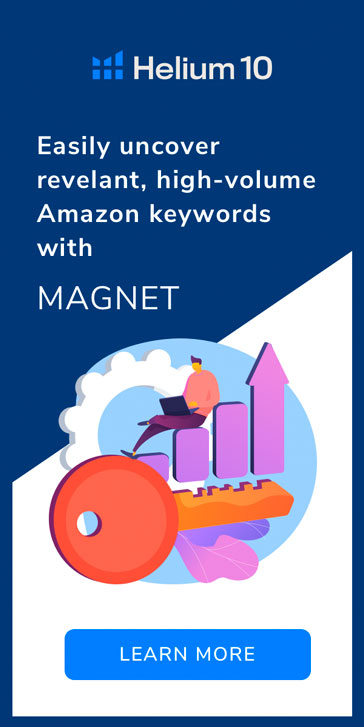We are living in an e-commerce renaissance. It’s not that the evolution, mass adoption, and universal accessibility of online shopping were unexpected ‒ however, the speed at which e-commerce blossomed over the last year has been truly remarkable.
It’s amazing what an abrupt, predominantly indoor lifestyle change can make.
In fact, online shopping (for almost every vertical) has seen growth.
Find more statistics at Statista
Looking at 2020 and Amazon specifically, monthly visitor growth is just about chart-breaking.
Find more statistics at Statista
As a writer for Helium 10, I am always trying to approach starting an online business in terms that are easiest to understand. After all, my job is to help you all learn e-commerce in the most painless way possible. It was for this very reason why I was so excited to tackle the philosophy of reselling products on Amazon, otherwise known as retail or online arbitrage.
It’s inherently one of the simplest methods of online selling to understand and turn a healthy profit if you know what you’re doing.
So if you are an arbitrage seller on Amazon… what are you doing?
What is Online Arbitrage? Is it Different Than Retail Arbitrage?
Simply put, arbitrage is the method of business where you, the seller, go out and purchase existing products being sold at a discounted price from an established retailer and resell them online at a marked-up price.
You’ll most likely hear both retail and online arbitrage thrown around, depending on who you’re talking to. The difference between the two, in theory, is negligible.
Retail arbitrage sellers purchase their inventory from brick-and-mortar stores (think Target or Walmart), where online arbitrage sellers source their products from online retailers.
Both retail and online arbitrage business models hinge on the same end goal: make a profit on Amazon!
Why be an Amazon Arbitrage Seller Rather Than a Private Label Seller?
While there are few things more rewarding than finding, sourcing, and sky-rocketing your very own private label product, there are more than a few things involved in doing so. When you sell your own product on Amazon, you are responsible for finding a manufacturer, negotiating with that manufacturer, staying on top of shipping logistics (often international), and maintaining inventory.
If you are an Amazon arbitrage seller, your primary concern is finding (existing) products. No suppliers, no lead time, no uncertainty.
Not sure if you’re ready to start selling your own product on Amazon? We have the perfect list of questions to help you decide if it’s time.
Ready to move on to a full guide to retail arbitrage? Check out our Retail Arbitrage 101 guide.
Is Arbitrage Oversaturated?
Wait, arbitrage sounds easy… dangerously so. Everyone is probably doing this, right?
Make no mistake, this is a popular method of selling products online. That being said, it often tends to be more popular in theory than in practice. Why? Arbitrage (especially retail arbitrage) is time-consuming. To be successful as an e-commerce reseller, you have to constantly be checking prices, hunting for sales, and visiting several brick and mortar stores to find the kinds of deals that will reap big money on Amazon.
Because of this, many would-be arbitrage sellers either give up before they even begin, or find out shortly after starting that it is not what they thought.
If you do have the time, patience, and right online arbitrage tools, however, there is serious success to be had.
How does $30,000 in sales over two weeks sound? Listen here (@ 10:47) to learn how our very own Bradley Sutton stumbled onto a retail arbitrage goldmine and made the absolute most of it.
This is an active model of online selling, but if you are the kind of person who feeds off of treasure hunting for the next great deal and beating people to the punch… retail/online arbitrage is perhaps the best way to learn the ins and outs of selling on Amazon while making some money in the process.
The Arbitrage Process, Step-by-Step
This is how the arbitrage process typically works for new sellers.
- Create an Amazon Seller Account (this is how you will list the items you find for sale to the largest online marketplace in the world)
- Download the Amazon Assistant or Amazon Seller App (you will use these tools to help you scan products you find, track sales, and check Amazon to compare current offerings on the market)
- Go Shop! Either online or in-person, visit your local big box stores and look for products that are cheap, easy to ship, and are (ideally) in-demand on Amazon already.
How are you supposed to gauge demand for a product on Amazon?
- List your products on Amazon at a higher price than you bought them for
- Pack and ship products yourself (as they sell) or let Amazon take care of things through FBA
Let’s walk through the arbitrage process together. Most of the time, whether you are practicing retail or online arbitrage, you will be purchasing your discounted products from big box stores (or their websites).
The most common are:
- Walmart
- Target
- Bed, Bath, & Beyond
- Home Depot
- Staples
- Big Lots
- Craigslist
- Let Go
- Facebook Marketplace
For example, within Walmart.com’s clearance section we find a good-looking product – in this case, a 16-pack of crayons for $0.57 per pack.
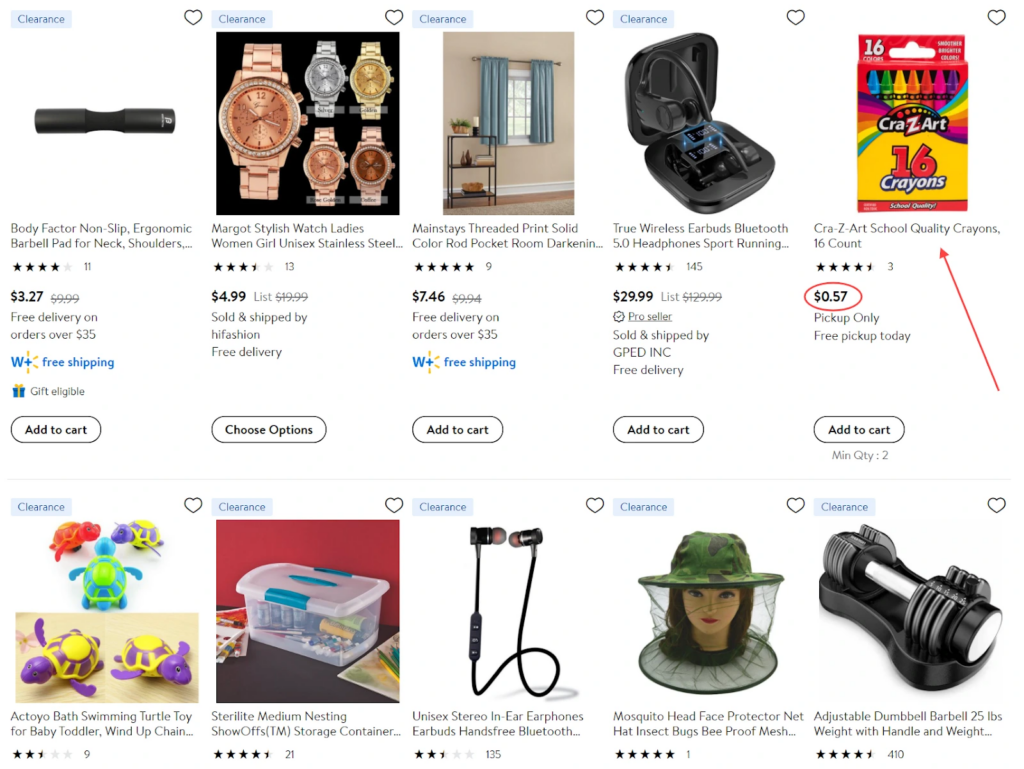
Running a quick Amazon search and using Helium 10’s Xray (part of our free Amazon chrome extension), we can see the average price for 16-count crayons on page one of search results is $13.00.
Not a bad start.
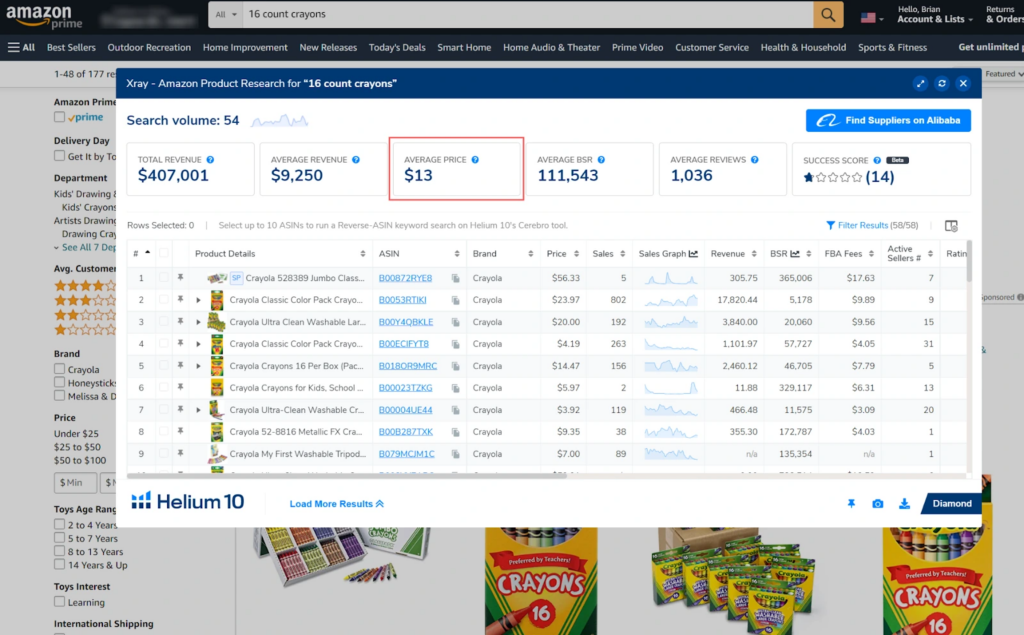
You might be thinking, “Great! That’s a ton of profit… let’s go!”
Well, as with selling anything with FBA, there are certain Amazon fees involved. If Amazon is going to pack, store, and ship products on your behalf, you can bet they’re going to take their cut.
Keep your calculators in the bottom of your desk drawer, we have something better to figure this all out.
Also part of the Helium 10 chrome extension is the Revenue and Profitability Calculators, both of which give you an estimated breakdown of the fees associated with using Fulfilled by Amazon and what you’ll be clearing in revenue after the fact. For our example, I used these calculators on an existing Amazon listing that looked closest to our Walmart find.

The Profitability Calculator, specifically, is extra fun because it allows you to plug in your own item dimensions, pricing, and any additional fees you may have to get an accurate look at your profit margin… all before you make any product decisions.
So far, it’s looking good!
Don’t forget, just because you find one listing for a product on Amazon, doesn’t mean there aren’t several other sellers offering the same exact thing (sometimes at a lower cost). Remember to look below the buy box!
Be wary of too much competition for any given arbitrage product, as you do not want to get stuck in a “race to the bottom” where you keep lowering and lowering your price to remain competitive until before you know it… you’re hardly making a profit at all.
Interested in using specialty online arbitrage tools to make bargain-hunting much easier (and a lot more fun)? We put together a list of online arbitrage tools and strategies to help you get started on the right foot.
Are There Any Tools out There That Can Make Me More Successful With Reselling on Amazon?
This is where things get fun. First of all, yes, there are several tools out there specifically geared towards online arbitrage sellers. Finding the right online arbitrage tool may be the difference between winning and losing with this business model.
Product sourcing tools help you scour the internet for the markets offering the products you’re after. Many of these tools offer alert functionality so when a new sale goes live, you’ll be the first to know. Think of product sourcing tools like your metal detector.
A great example of a product sourcing tool is Invisible Hand. When you shop online with their chrome extension activated, you will automatically be notified if there is a cheaper deal elsewhere and given a link to take you straight to it.
Product trend tools help you identify new arbitrage opportunities as well as crack the code of timing the market. Seasonality can play a major role in arbitrage success – you don’t want to write off the right product merely because you happened to be re-selling in the wrong month.
Black Box is an Amazon product research tool that turns Amazon’s entire product database into your own personal search engine. Black Box helps you zero in on winning product ideas by giving you the ability to filter products by:
- Estimated monthly revenue
- Price
- Review rating (and review count)
- Best Sellers Rank
- Fulfillment method
If you’re looking for the quickest way to check for product seasonality, Trendster is one of the easier ways to find out. Just plug in an ASIN and/or key phrase and get instant 24-hour, 7-day, 30-day, 90-day, one-year, and all-time data graphs for price and sales rank on Amazon. You also get Google search trend results baked in.
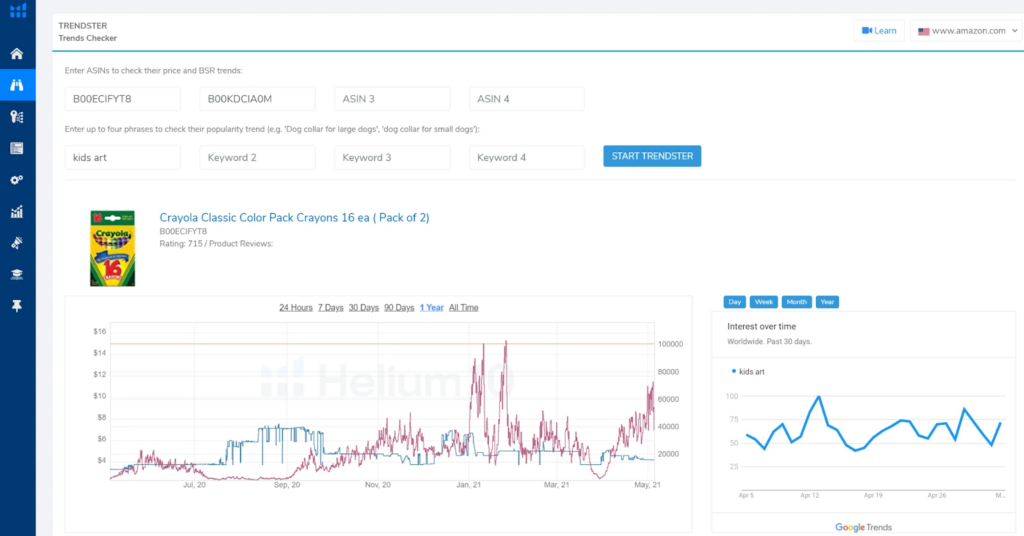
Curious about more tools, including product scanner apps? We did an entire write-up on the best online arbitrage tools for sellers just for you!
Ready to Open Up Your Online Store?
Both online and retail arbitrage are simple, but that doesn’t always make them easy. Almost everyone can understand the concepts of buying low and selling high. Few have the patience, tenacity, and toolbelt to actually pull it off (and pull it off consistently).
At the very least, I hope that you understand arbitrage selling a little better and now have a head start on the competition when it comes to Amazon selling tools. While arbitrage is rarely the online selling model that will allow you to quit your day job, we would suggest using it as a way to learn the Amazon selling process and make your mistakes while you have little to no overhead. Then, when you’re ready, take that experience and start your own private label brand.
Happy hunting!
Read original post from https://www.helium10.com/blog/getting-started-amazon-arbitrage/













